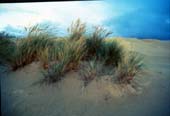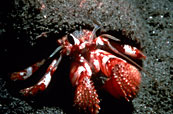Curriculum Overview
Knowing the Sandy Beach
 It takes some detective work to "read" a sandy beach. Evidence of life is everywhere, but the actual life may be hard to find. Footprints, feathers, seaweed, shells, garbage, and oil may tell a story of who has visited a sandy beach. Even the shifting sands tell a story of formation, erosion and seasonal cycles of this coastal ecosystem.
It takes some detective work to "read" a sandy beach. Evidence of life is everywhere, but the actual life may be hard to find. Footprints, feathers, seaweed, shells, garbage, and oil may tell a story of who has visited a sandy beach. Even the shifting sands tell a story of formation, erosion and seasonal cycles of this coastal ecosystem.
Read up! for Teachers
Natural History
At MARE's request, naturalist Robin Milton Love wrote this accessible background essay on the natural history of the Sandy Beach.
MARE's Teacher Background for the Sandy Beach (pdf)
Hermit Crab Activity Tips
 Tropical land hermit crabs make good classroom pets. Carolina Biological or your pet store can order them. Give them a few different size snail shells and they might try them out!
Tropical land hermit crabs make good classroom pets. Carolina Biological or your pet store can order them. Give them a few different size snail shells and they might try them out!
Although most hermit crabs do not, tropical marine "decorator" hermit crabs do actually decorate their shells like the star of Eric Carle's book, A House for Hermit Crab.
Websites
You can now search for Habitat specific web links through the Resource Materials search.
To find general web links about ocean sciences, visit the useful web links page in our News section.
Teaching the Sandy Beach
The 2nd grade MARE curriculum includes themes of the rock cycle, invertebrates and marine mammal adaptations.
Join MARE's Sandy Beach Forum!
 Contribute your ideas and ask questions of other people teaching about the Sandy Beach. New features of this website and professional development opportunities will be shared in the Forum.
Contribute your ideas and ask questions of other people teaching about the Sandy Beach. New features of this website and professional development opportunities will be shared in the Forum.
Visit the Sandy Beach Forum now
Field Trip Tips
- Don't worry about the lack of abundance of creatures on a field trip. A few birds might draw more thoughtful attention than a whole flock. In fact, a first field trip might be planned for when the tide is not optimal, or the migration season isn't optimal. Fewer stimuli may help your students practice *focus* as they observe. If you're able to have multiple field trips, try the migration-peak or really-low-tide experience later.
- Balance the need to identify organisms with the need to observe them. Get more out of seeing an organism than just the name!
Order Now, Grade 2 Sandy Beach
Sandy Beach Teacher Guides may be ordered at our online store or directly from MARE.

 Second grade curriculum is focused on the Sandy Beach.
Second grade curriculum is focused on the Sandy Beach.



